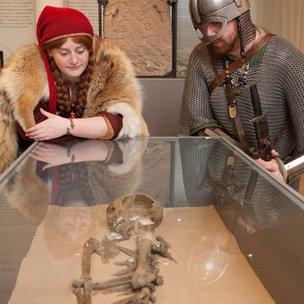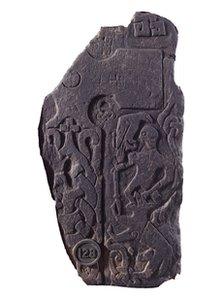Viking burials explored at Valhalla exhibition in York
- Published

The exhibition will feature evidence of Viking burials
Artefacts and human skeletons found at Viking burial sites go on display later in a major new exhibition in York.
The Valhalla exhibition claims to reveal more about the life of Vikings in Britain and the Isle of Man using the latest forensic techniques.
The York Archaeological Trust display opens at Jorvik Viking Centre.
It is the result of collaborations with York Minster and Manx National Heritage (MNH). Allison Fox, of MNH, described it as "incredibly exciting".
Included in the exhibition is evidence of Viking burials across the British Isles, bringing together key findings and exploring the latest research techniques.
Facial reconstruction
On show are Viking skeletons from the Hungate dig in York and the York Minster stones found in excavations carried out by York Archaeological Trust.
The trust spent five years working on the Hungate dig, revealing Viking-age cellars and the remains of a Roman cemetery.
The excavation also found a roman necklace and rare jet jewellery dating from the 3rd or 4th centuries.
Sarah Maltby, director of attractions at York Archaeological Trust, said: "Looking at this evidence, alongside artefacts found throughout the British Isles, helps tell a more accurate story of Viking Britain and our Viking ancestry."
The exhibition also tells the story of a Viking man whose remains were found in the Balladoole ship burial in the Isle of Man.
Using forensic science, researchers can tell he was a 45-year-old man who died in or around AD 950. A likeness of his face has been created using the latest facial reconstruction technology.
Boat burials
Mrs Fox added: "In archaeology, it's through the dead that we can recreate the living, and talking about the rites and rituals of the Vikings can go some way to understanding the people themselves.
"We can even, quite literally, put a face to the dead in the case of the Viking burial at Balladoole, here in the Isle of Man."

A replica of Thorwald's Cross is on display at Jorvik
Also on display at Valhalla is a replica of Thorwald's Cross, one of around 200 crosses found on the Isle of Man and thought to depict the <link> <firstCreated>2010-02-05T10:19:10+00:00</firstCreated> <lastUpdated>2010-02-05T10:19:10+00:00</lastUpdated> <caption>transition of the Viking world of pagan beliefs to the introduction of Christianity</caption> <url href="http://news.bbc.co.uk/local/isleofman/hi/people_and_places/history/newsid_8498000/8498950.stm" platform="highweb"/> </link> .
The first Vikings arrived from Scandinavia via the Irish Sea at the end of the 8th Century, not just to raid but also to trade along the western seaboard of the British Isles.
Warrior burials have been found in the Isle of Man, where the dead have been accompanied with the grave goods needed to serve them in the afterlife.
Boat burials have been excavated in the island at Balladoole and Knock y Doonee.
The Norse also brought with them the concept of an open-air assembly of free men where the old laws were ratified, new laws submitted for approval and judgement given on law breakers.
This took place at Tynwald Hill and the government of the Isle of Man is still known as Tynwald.
Viking sites in the Isle of Man also include The Braaid Viking farmstead and Peel Castle.
- Published21 October 2011